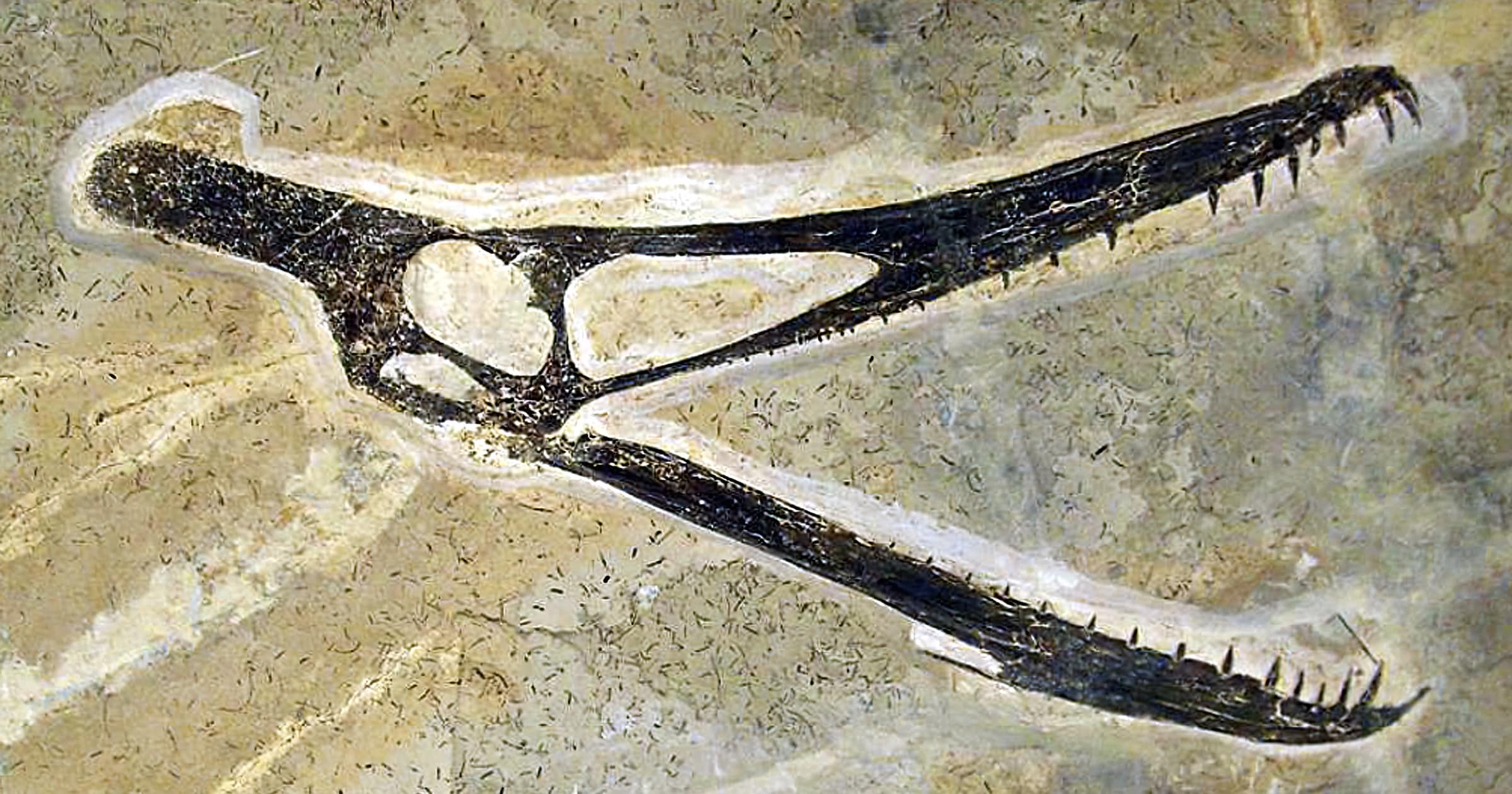 Evolution
Evolution
 Intelligent Design
Intelligent Design
 Paleontology
Paleontology
Fossil Friday: Ludodactylus and the Origin of Pterosaurs

This Fossil Friday I want to show you a very well-preserved skull of a giant pterosaur from the Lower Cretaceous Crato Formation, which is about 115 million years old. I could photograph this specimen at a German trader’s collection in 2008, unfortunately only with a poor camera in low resolution. This fossil most likely belongs to the ornithocheirid species Ludodactylus sibbicki, which is otherwise only known from the holotype specimen (Frey et al. 2003, Unwin & Martill 2007). The holotype lacked the distal portion of the head crest, so that this yet undescribed specimen, which is here figured for the first time ever, finally shows how this crest really was shaped. The skull is 53.5 cm long and the estimated wing span of this species was up to 4 meters (Unwin & Martill 2007). These animals probably fed on fish on the open sea, similar to living albatrosses.
Pterosaurs had a unique construction of their wings, which were mainly supported by an enormously enlarged fourth finger. This is very different from the construction of the wings in bats and birds. Pterosaurs appear abruptly and fully formed in the fossil record of the Upper Triassic (Norian), about 227–208 million years ago, with eopterosaurs like Preondactylus and Carniadactylus. Pterosaurs are believed to be relatives to Late Triassic “reptiles” like Lagerpetidae (Ezcurra et al. 2020, Kammer et al. 2020, Baron 2021), and the enigmatic Scleromochlus (Benton 1999, Bennett 2020, Foffa et al. 2022). However, those reptiles fail to show even the slightest adaptations for gliding or flying, or any trace of incipient pterosaur wings. Even the relationship of these fossils is highly disputed, e.g., with Bennet (2020) in his extensive study strongly rejecting any closer relationship of Scleromochlus with pterosaurs, while Foffa et al. (2022) strongly affirms it, which was celebrated in the media as “Scottish fossil revealed to be pterodactyl ancestor” (Gill 2022).
A Lack of Transitional Fossils
Outside of Darwinian fantasy land, we indeed lack any transitional fossils that would document an assumed gradual evolutionary development of characteristic pterosaur wings. In my view this strongly suggests that the transition happened very quickly as an abrupt saltation rather than mediated by hundreds of transitional species, for which there is not a shred of empirical evidence. Such saltations could not be explained by an unguided neo-Darwinian mechanism of natural selection acting on random mutations, but would require a massive infusion of new genetic and epigenetic information from outside the system. Therefore, the abrupt origin of pterosaurs clearly points to intelligent design as the best explanation.
References
- Baron MG 2021. The origin of Pterosaurs. Earth-Science Reviews.221: 103777, 1–14. DOI: https://doi.org/10.1016/j.earscirev.2021.103777
- Bennett SC 2020. Reassessment of the Triassic archosauriform Scleromochlus taylori: neither runner nor biped, but hopper. PeerJ 8: e8418, 1–77. DOI: https://doi.org/10.7717/peerj.8418
- Benton MJ 1999. Scleromochlus taylori and the origin of dinosaurs and pterosaurs. Philosophical Transactions of the Royal Society of London B 354(1388), 1423–1446. DOI: https://doi.org/10.1098/rstb.1999.0489
- Ezcurra MD, Nesbitt SJ & Bronzati M et al. 2020. Enigmatic dinosaur precursors bridge the gap to the origin of Pterosauria. Nature 588(7838), 445–449. DOI: https://doi.org/10.1038/s41586-020-3011-4
- Foffa D, Dunne EM & Nesbitt SJ et al. 2022. Scleromochlus and the early evolution of Pterosauromorpha. Nature 610(7931), 313–318. DOI: https://doi.org/10.1038/s41586-022-05284-x
- Frey E, Martill DM & Buchy M-C 2003. A new crested ornithocheirid from the Lower Cretaceous of northeastern Brazil and the unusual death of an unusual pterosaur. pp. 55–63 in: Buffetaut E & Mazin J-M (eds). Evolution and Palaeobiology of Pterosaurs. Geological Society of London – Special Publications. Vol. 217. [Google Books]
- Gill V 2022. Scottish fossil revealed to be pterodactyl ancestor. BBC News October 6, 2022. https://www.bbc.com/news/science-environment-63146271
- Kammerer CF, Nesbitt SJ, Flynn JJ, Ranivoharimanana L & Wyss AR 2020. A tiny ornithodiran archosaur from the Triassic of Madagascar and the role of miniaturization in dinosaur and pterosaur ancestry. PNAS 117(30), 17932–17936. DOI: https://doi.org/10.1073/pnas.1916631117
- Unwin DW & Martill DM 2007. Pterosaurs of the Crato Formation. pp 475–524 in: Martill DM, Bechly G & Loveridge RF (eds). The Crato Fossil Beds of Brazil: Window into an Ancient World. Cambridge University Press, Cambridge (UK), xvi+625 pp.
